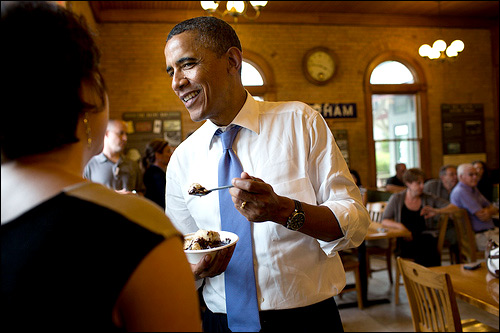A series of new polls from three major swing states -Florida, Ohio and Pennsylvania – reveals that voters basically support President Barack Obama’s immigration policy, but are split on his handling of the economy.
Quinnipiac University released their research data this week from polls simultaneously conducted in those critical swing states, and the results reveal that the president has a discernible advantage over presumptive Republican nominee Mitt Romney in the three places, the culmination of which could decide the election. The polls, all from the June 19-25 period, report the following ballot test findings:
• Florida: Obama 45 percent – Romney 41 percent (1,200 Florida voters)
• Ohio: Obama 47 percent – Romney 38 percent (1,237 Ohio voters)
• Pennsylvania: Obama 45 percent – Romney 39 percent (1,252 Pennsylvania voters)
Since 1960, history dictates that no one has won the White House without taking at least two of the three aforementioned states. In comparing these results with the similar May 3 Q-Poll findings that gave Obama an eight-point lead in Pennsylvania with Florida and Ohio in virtual dead heats, suggests that the president has gained recent momentum. Today, Obama has clear leads over Romney in the three critically important states and, if such a pattern continues throughout the summer and into autumn, he stands in good position to secure a second term. Keeping in mind that voter disposition over a four-month time period in the modern campaign era can quickly change, this new data again suggests that the 2012 presidential contest will be tight in these three major battleground states.
The polls yield several basic conclusions. Initially, Florida, Ohio and Pennsylvania polling respondents support President Obama’s new immigration policy and are divided over whether he or Romney would be better for the country’s economy and their personal finances.
In Florida, on the heels of the President’s recent decision to prevent deportation of younger Illegal immigrants, Mr. Obama holds a sizable lead among Hispanic voters. Specifically, the Q-Poll indicates an Obama support factor within the Florida Hispanic cell segment at 56-32 percent, compared to 49-39 percent in the May Quinnipiac University poll. The earlier survey was in the field prior to Obama and Romney each making their respective immigration policy speeches. Increasing Republican share of the Hispanic voting block is crucial to a Romney win formula.
Furthermore, Obama leads in other demographic group cell sectors as well, including 85-6 percent support among black voters, which actually could be a low number when compared with voter history from 2008. White voters in Florida back Romney 50-35 percent. Obama also leads among Sunshine State women, 47-40 percent, while men are evenly divided with 43 percent for Obama and 42 percent for Romney.
In Ohio, we find similar results as the Buckeye State Q-Poll reveals 52-38 percent support for the president’s immigration policy. By a margin of 45-38 percent, respondents say he would do a better job than Romney in handling immigration. Obama currently possesses a discernible lead among Ohio Independents, which historically have proven to be a bellwether in determining which way the state will swing.
Pennsylvania women are strongly backing the president according to the Keystone State Q-Poll (48-36 percent), with men tipping 42-41 percent toward Romney. Voters in Pennsylvania don’t necessarily approve of the way Mr. Obama is handling his job as president, split 45-47 percent favorable to unfavorable, but his numbers are better than Romney’s upside down 34:39 percent personal image ratio.
In conclusion, the Florida, Ohio and Pennsylvania polls provide strong indications about which way the country will swing this fall. Today, it is fair to say that this race is still up for grabs, but the president clearly maintains the easier path to ultimate victory in November.


